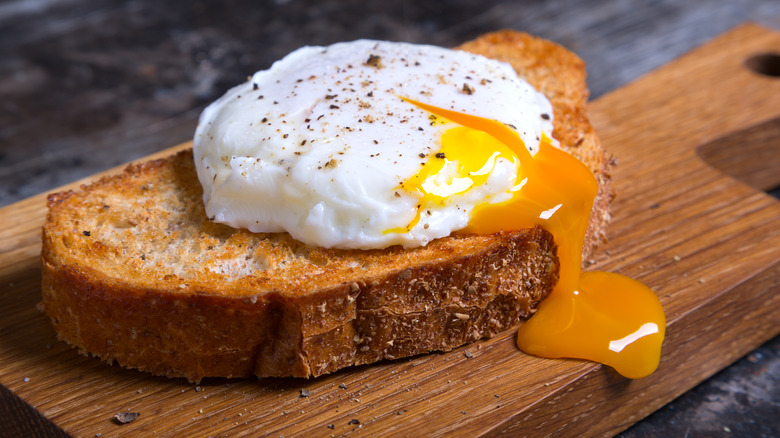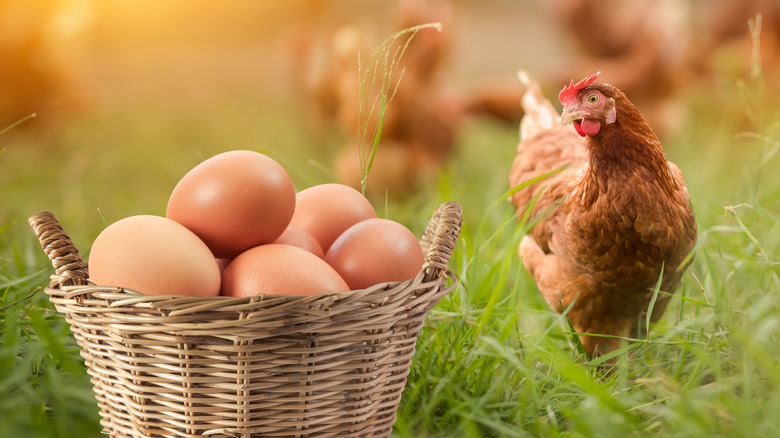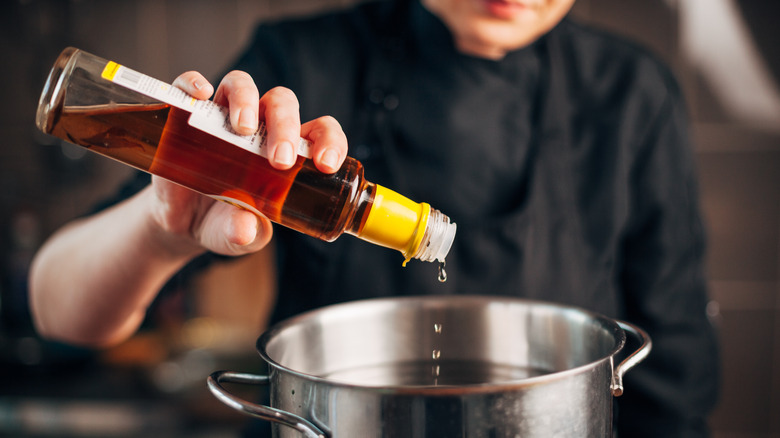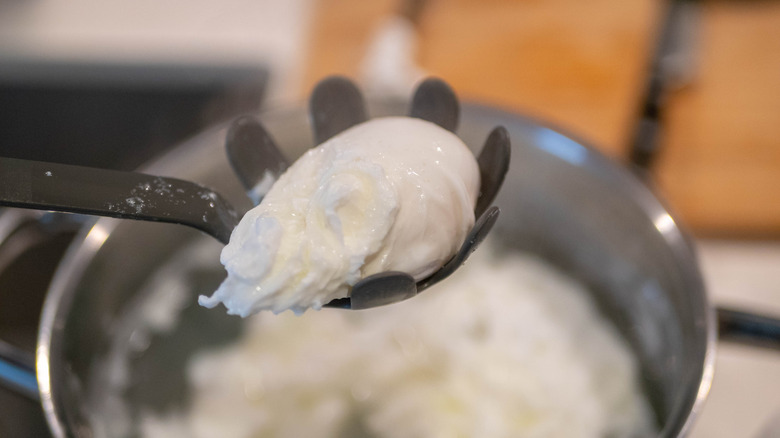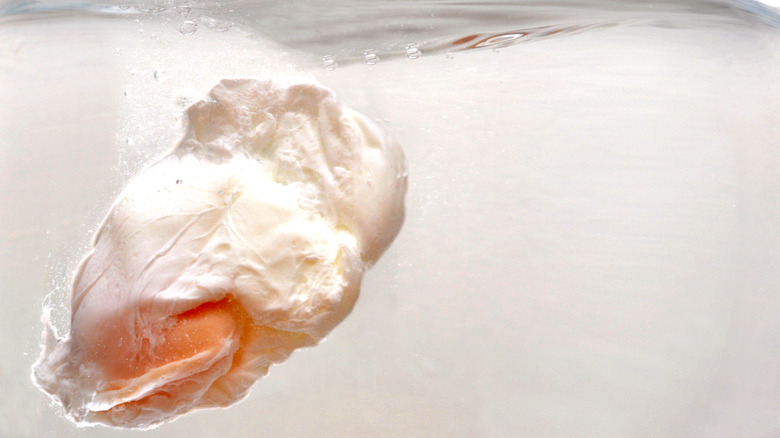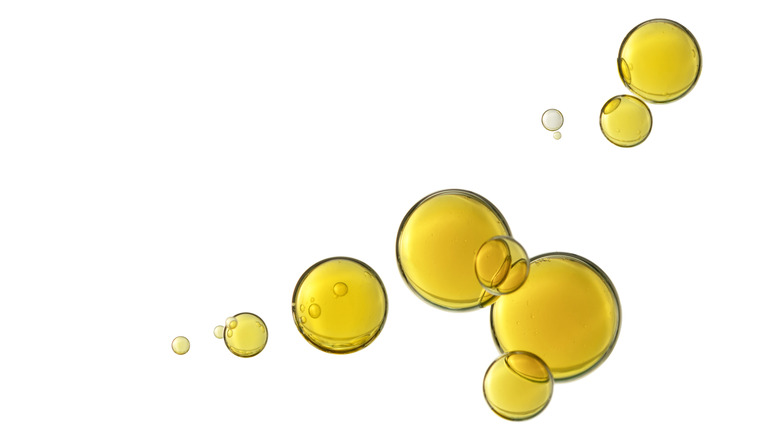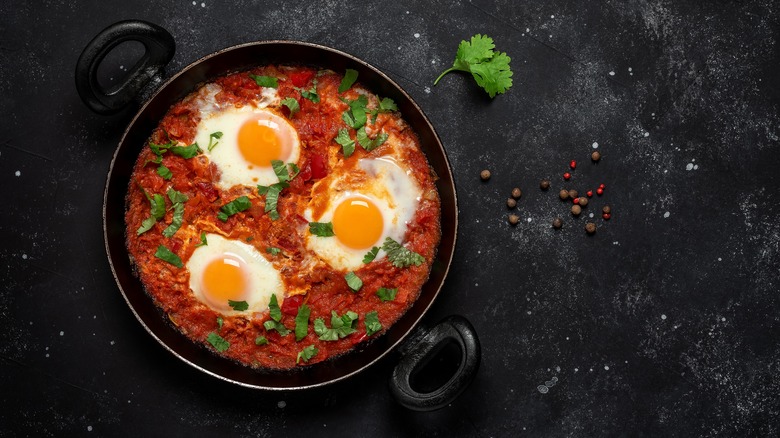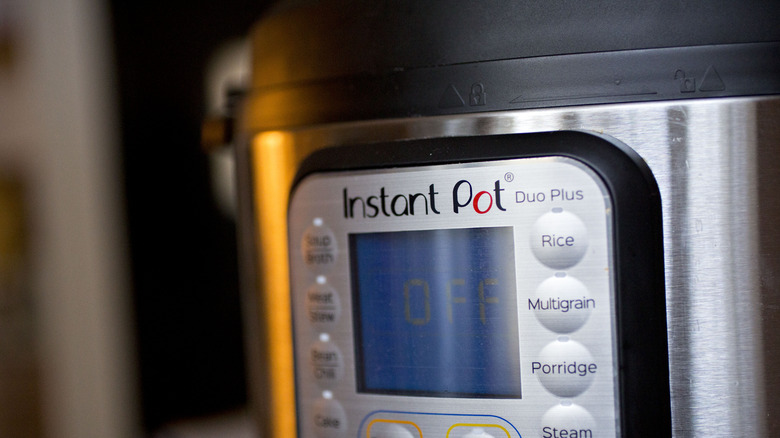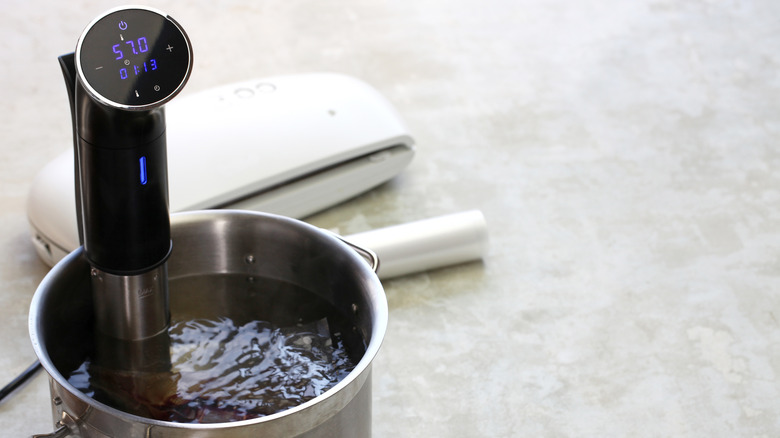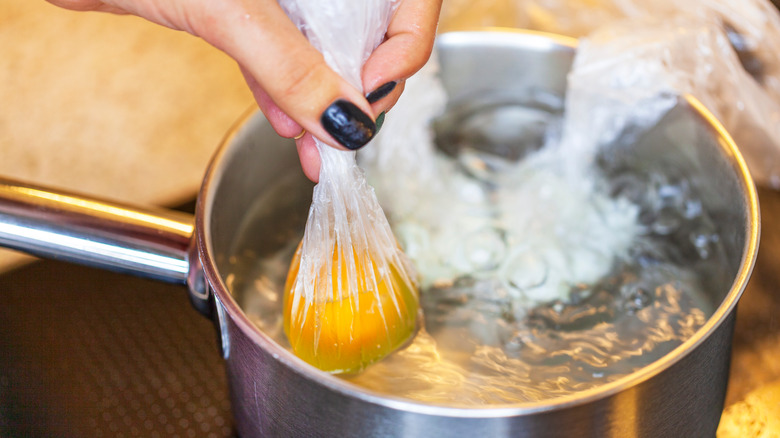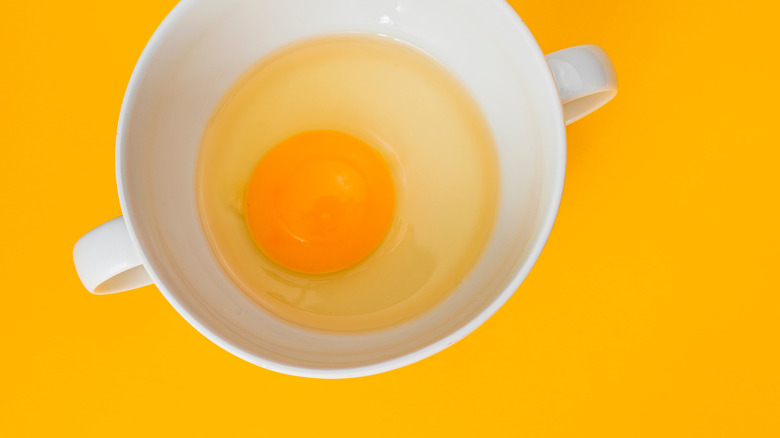11 Different Methods For Poaching Eggs
Everyone loves breakfast, and poached eggs in eggs benedict are a big reason. So why doesn't everyone — or, perhaps more accurately, just about anyone — make poached eggs at home? The answer to that question is that it's probably because people think poaching eggs is hard.
Here's the good news: it isn't. Poaching eggs is deceptively easy. So why do so many folks think it's hard? Part of the problem is that there are a lot of myths and misinformation floating around. Many of those myths and much of that misinformation are stated with an air of absolute authority. Most of that advice is, of course, well-intentioned, but that does not make it accurate. Much of it is directly about the right ways (and sometimes the wrong ways) to poach eggs. But for every confident bit of advice, it seems, there is an equal and opposite bit of advice or disinformation.
We're here to help you sort through all of that. Understanding the different methods for poaching eggs along with the benefits of each is an excellent place to start. Begin there, and poaching eggs at home will not seem nearly so daunting. It's a short road to Sunday morning hollandaise and eggs benedict at the breakfast table.
It's important to use fresh eggs
The single most important decision to make in poaching eggs is to use fresh eggs. As NPR points out, there are multiple reasons for this. To understand, you need to know the structure of an egg and how aging affects that structure. Chicken eggs consist of six parts: the yolk, thin and thick albumens (egg whites), chalazae (a flexible chain that holds the yolk in suspension), and an air cell. As eggs age, water from the albumens migrates into the yolk and, as Animals observes, the proportion of thick to thin albumen decreases. This results in the stringy, messy appearance of poached eggs that no one likes.
The best way to determine the freshness of the eggs is to check the Julian date on the egg carton. This can be a little bit confusing because there are two sets of numbers corresponding to dates on the short side of each egg carton. As the Egg Safety Center explains, the top date is the familiar "sell by" date. That is not the one you're looking for. Just below it is a code that corresponds to the date on which the eggs were packed: the Julian date. This three-digit code represents the day of the year the eggs were packed — January 1 is 001 and December 31 is 365. Pick the carton with the highest Julian number you can find. Some brands put a four-digit code (two-digit month and two-digit day), so 1231 for December 31.
Use an acid in with the water
There may be no more prevalent bit of egg poaching advice than to add something acidic — most commonly vinegar or lemon juice — to the poaching liquid. The purpose is to reduce the pH of the water to speed up the denaturing of the proteins and reduce the cooking time (per Appeasing a Food Geek). As the Victoria University of Wellington points out, adding vinegar to the poaching water has the additional benefit of helping the poached egg to better hold its shape.
Of course, like just about everything else involved in poaching eggs, there are some who eschew that classic bit of advice. While those who oppose adding vinegar to the boiling water often recognize the benefits, their concern is that doing so can make the poached eggs taste like vinegar, as On the Gas says. But will it? How vinegary is a large pot of water really going to taste with a tablespoon or two of vinegar dispersed in it? Answer: not very.
Of course, not all myths about what to add to the poaching liquid are based in fact. One common bit of lore is that adding salt to the poaching liquid helps by increasing the water's density to allow the eggs to float to the surface when cooked. Don't do it. As the Staten Island Advance points out, adding salt to the poaching water just stiffens the whites. It even runs the risk of breaking up the egg.
Add a whirlpool for that classic vinegar and vortex combination
If a touch of acid in the water is the most common piece of advice on how to poach eggs, the next most common — its perfect companion — is to create a whirlpool into which you (carefully) introduce the eggs. The essence of this method for poaching eggs is to use something like a wooden spoon to forcefully spin around the inside perimeter of the pot to create a whirlpool, or as famed Chef Thomas Keller put it, a "vortex." The purpose of the vortex is to make sure the whites of the egg stay together as they poach. Chef Geoffrey Zakarian does much the same, dubbing them "perfectly poached eggs."
But while the vortex method helps tame the egg whites and the vinegar method speeds up the denaturing process, thus helping the eggs hold their shape, perhaps the ultimate fool-proof method is doing both. It's a classic combination and is one of the key secrets to achieving perfect poached eggs. The synergy of the cohesive effect between the vinegar combined with that vortex creates beautiful (and delicious) results.
Poach your eggs in deep water with the KISS method
Since every bit of advice as to how to make the perfect poached egg has an equal and opposite response, some insist that the best way to poach an egg requires neither vinegar nor the creation of a vortex. Man Cave Chef, for example, argues that vinegar will result in overcooked egg whites and the vortex is limited because you can only cook one egg at a time. Others disagree, as demonstrated by this deluxe poached egg recipe, complete with the instruction to add eggs to the center of the vortex one at a time. Others argue vinegar does not eliminate stringy whites but does render them chalky and simply contend swirling just does not help.
Those who advocate eschewing the vinegar and the vortex tend to favor one other thing: cooking the eggs in deep water. Man Cave Chef, for example, says to use at least three quarts of water. Deadspin (which uses vinegar) says to fill a pot to a depth of five to six inches of water regardless of the size of the pot itself. The idea is to preserve the form of the egg by letting it sink to the bottom of the pot and then rise back to the surface without actually hitting the bottom.
Consider olive oil for confit-like flavor
Don't sleep on olive oil as your egg poaching fluid. After all, at its most basic level, a poached egg is just an egg that has been lowered into a simmering (but not boiling) liquid until the whites (but not the yolk) become firm. Unlike water, which is flavorless, good quality extra-virgin olive oil brings a whole lot of flavor to the egg poaching party. Do you want still more flavor? Add some garlic or herbs to the poaching oil. The eggs get to be the beneficiary.
Another way of conceptualizing poaching eggs in olive oil is to think of it like a confit. As Great British Chefs explains, the process of confiting is essentially poaching proteins or vegetables in fat until they become tender and, of course, delicious. That's exactly what happens when poaching eggs in olive oil.
This method has another serious benefit: it's easier! Just crack the egg in the pan and baste the egg with olive oil. Oh Joy! describes it as a fried egg with a poached egg in the middle. The most difficult part of poaching eggs in olive oil is remembering to keep the egg moving to prevent it from browning and ensure the yolk stays creamy.
Try using other liquids
Since water isn't the only poaching liquid for eggs, it stands to reason that olive oil is not the only alternative. One option is stock, broth, or even simple bouillon. After all, they are all pretty much like water, only more flavorful. If eggs are not rich enough for you, try poaching them in cream, as suggested by WNYC.
Or, perhaps you should try using wine. In addition to being flavorful and healthful, when you poach eggs in wine you bring color to the party. Red wine-poached eggs arrive at the table both rich and tasty with a vibrant purple color. White wine-poached eggs, on the other hand, offer more delicate flavor notes. Take, for example, the French answer to eggs benedict: oeufs en meurette (aka oeufs a la bourguignonne). It is eggs poached in a classic French meurette sauce based on pork belly with mushroom, shallots, aromatics, and a whole lot of Burgundy wine. The acidity of the wine prevents the egg proteins from unraveling and, not incidentally, lends the eggs both a gorgeous, violet color and tremendous flavor.
But the French have no monopoly on colorful poached eggs. There is hardly a Mediterranean, Middle Eastern, or North African culture that does not have its own take on shakshuka — a dish of eggs poached in a brilliant red, peppery broth of tomatoes, onions, and chiles. And though they may differ slightly, they're all uniquely delicious.
Poach eggs in the microwave ... or don't
The classic method of poaching eggs in water (or other liquids) is classic because it works well. But it is hardly the only way to do the job. Newer technologies have offered additional options. The quickest, and quite possibly the easiest of those is likely sitting on your kitchen counter.
To poach an egg in the microwave, just fill a big coffee mug with a cup of water up to an inch from the top. Microwave the water in the mug for a minute and a half at full power, then add a teaspoon of vinegar and crack an egg into the water. Cover the mug with a paper napkin and zap the mug for another 35 seconds on 80% power. It is that simple.
Of course, unsurprisingly, some believe you should think twice before making poached eggs in the microwave. As Irish Central reported, a Northern Irish woman named Áine Lynch ended up in the hospital after her eggs exploded as she was poaching them in the microwave oven, severely burning her. One way to protect against that danger is by slightly piercing the egg yolk with the tip of a knife to prevent the egg from exploding.
Make use of the Instant Pot
Another popular kitchen gadget, the Instant Pot, offers significant benefits in poaching eggs. For those not learned in the lore of the Instant Pot, it is a remarkably versatile multicooker. It can basically take the place of a pressure cooker, rice cooker, egg cooker, steamer, or warmer, and you can even sauté in it, as Good Housekeeping explains.
But as versatile as the Instant Pot surely is, it really shines when it comes to making poached eggs. Crack your eggs into ramekins and place them on a rack inside the Instant Pot. Cook the egg-filled ramekins for one minute on high pressure and they should be done. It's easy to tell if they are: Once the whites of the eggs are no longer translucent, you're good to go. You can leave the eggs in longer, but be careful — the longer you leave them in the Instant Pot, the more solid the yolks will become. Nobody likes "poached" eggs with hard yolks.
Use a sous vide to poach your eggs
Another decidedly contemporary — if not slightly futuristic — approach to poaching eggs is sous vide. It is a cooking method in which proteins (most commonly) are cooked to a precise temperature in a water bath using an immersion circulator. Once the domain of fine dining chefs, this equipment is now widely available for home cooks.
The precision of the sous vide method works well for poaching eggs. It helps get around some of the challenges of more traditional egg poaching techniques. Indeed, there is more than one way to do it. You could simply cook the eggs in their shells using the sous vide method to achieve a steady 145 degrees Fahrenheit for between 45 minutes and one hour. Or you can save a lot of time cooking the egg sous vide by removing the shell. Crack the egg into some well-oiled cling film, as Lifehacker suggests, tie off the plastic wrap with string, and three minutes in the sous vide water bath will do the trick.
Perhaps the real beauty of the Lifehacker sous vide technique is all the creative flavoring possibilities it opens up. You can add any combination of herbs and spices you want. You can do so on top of the oiled plastic wrap or you can do it on top of the egg before wrapping and tying the package. It is the combination of both precision and the level of flexibility in adding flavor to poached eggs that are unique to the sous vide egg poaching method.
Cling film can come in handy
You do not need to cook sous vide to get some of the benefits of using cling film. As documented by Insider, Jaime Oliver puts plastic wrap into ramekins along with a bit of oil, then cracks an egg into the plastic-lined ramekin before tying it up and poaching the packet in simmering water for three minutes. This technique has several distinct advantages.
First, while you don't have the precision of the sous vide method, you do have the opportunity to flavor the egg in the packet as it cooks. Second, using the plastic wrap insures you will have that perfectly shaped poached egg. Third, and significantly, if you need to poach multiple eggs you can cook them all at the same time.
For all the benefits of poaching your eggs in cling film, it is worth noting that some people — though generally not the authorities — have lingering concerns as to whether cooking in plastic wrap is safe, per Modernist Cuisine. Generally speaking, most of today's newer, reformulated plastic wraps are significantly safer than the older generation products made from polyvinyl chloride (PVC), per Dr. Weil.
Crack the eggs into something that makes it easier to pour into the water
One of the basic challenges many cooks face with classic egg poaching techniques is the question of how to get the egg into the water. Simply cracking the eggshell and dropping the egg into a pot of simmering water is, not to put too fine a point on it, just not going to work. The whites of the eggs would become an irrevocably chaotic mess that will not come back together, and you might even break the yolk. The basic answer is to get a tool to help with the job. Conventional wisdom on how to poach an egg perfectly has you crack the egg into a small bowl or ramekin and then carefully tip the egg into the pot (preferably after creating the whirlpool). That technique does, in fact, work.
As Stela's Food Stories, amongst others, points out, famed British Chef Heston Blumenthal came up with a better solution by recommending a better tool: a fine mesh strainer. Straining eggs before adding them to the pot offers multiple benefits. First, it removes excess wispy, loose whites (the thin albumen), and that helps create tight, perfectly shaped eggs. Secondly, and perhaps more critically, just lowering the strainer into the pot and gently shaking it to loosen the egg from the surface of the strainer gets the eggs safely into the pot.
